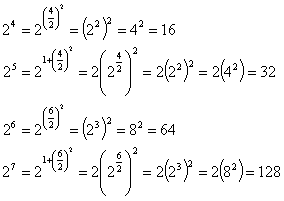| Recursion Studies |
It is virtually impossible to provide practical programming solutions to a variety of complex problems without recursion. As such, it is an indispensable programming strategy.
The Key
Successful implementation of a recursive solution depends on your ability to define a recursive solution on paper. For example, the power function, xn can be defined non-recursively as,
Defined recursively, we write,
 |
(1) |
From (1), the implementation is straightforward. Successful recursive solutions arise from the programmer being able to express a definition similar to (1) for each new problem, that includes both the general inductive substitution expression and a basis or stopping condition.
Examples
The table below suggests algorithms that lend themselves to recursive solutions. Develop methods to satisfy the stated purpose and a sample driver to test them.
| Grade | Topic | Type | Purpose |
| 11 | Sum | Num | Determines `1+2+3+...+n=Sigma_{i=1}^n i` |
| 11 | Factorial | Num | Determines `n\times (n-1)\times (n-2)\times...\times3\times2\times1 = n! = Pi_{i=1}^n i` |
| 11 | Pascal's Triangle | Num | Determines elements from Pascal's Triangle |
| 11 | Fibonacci | Num | Determines and displays terms from the Fibonacci sequence: `1,1,2,3,5,...` See: |
| 11 | Square Root | Num | approximate a square root by guessing |
| 11 | GCD | Num | Euclid's algorithm for determining the greatest common divisor |
| 11 | Base Conversion | Num | Converts decimal numbers to any other base (<10) |
| 11 | Reverse Bits | Num | Reverse the bits of register (16-bit) |
| 11 | Palindrome | Char | Reverses the order of the characters in a string |
| 11 | Matching Brackets | Char | Uses a stack to confirm matching brackets in an expression |
| 12 | Root finding | Num | Uses Newton's Method to determine a root of a function, `x_{i+1}=x_i-\frac{f(x_i)}{f'(x_i)}` |
| 12 | Successive Approximation | Num | Anaolog to Digital Conversion (Similar to Newton's Method) |
| 13 | Determinants | Num | Solves determinants recursively for use in Cramer's Rule |
* Mathjax Reference: https://math.meta.stackexchange.com/questions/5020/mathjax-basic-tutorial-and-quick-reference
Improved Power Method (Adapted from Data Structures and Algorithms, Goodrich and Tamassia)
The complexity of the power function function above is O(n). We can compute the power function much faster than this however, by using the following alternative recursive definition, which employs a squaring technique as illustrated by the following examples,

A close examination of the examples suggests that each recursive call to divides the exponent by two. Thus, there are O(log n) recursive calls, not O(n). That is, by combining recursion with the squaring technique, we reduce the running time for the computation of the power function from O(log n) to O(n) - a significant improvement.
Task.
|
 |